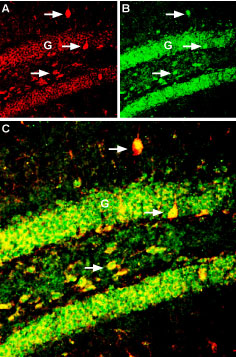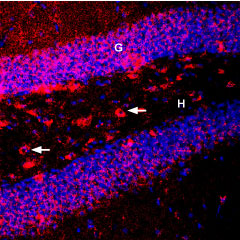Overview
Cat #: BLP-NT010
Type: Synthetic peptide
Form: Lyophilized powder
BDNF Blocking Peptide (#BLP-NT010) is the original antigen used for immunization during Anti-BDNF Antibody (#ANT-010) generation. The blocking peptide binds and ‘blocks’ Anti-BDNF primary antibody, this makes it a good negative reagent control to help confirm antibody specificity in western blot and immunohistochemistry applications. This control is also often called a pre-adsorption control.
Applications: wb, ihc
Application key:
WB- Western blot, IHC- Immunohistochemistry
For research purposes only. not for human use
Applications
Demonstration of Pre-adsorption control
 Western blot analysis with Anti-BDNF Antibody:1,5. Recombinant human BDNF protein (#B-250).
Western blot analysis with Anti-BDNF Antibody:1,5. Recombinant human BDNF protein (#B-250).
2,6. Recombinant mouse proBDNF protein (#B-240).
3,7. Recombinant human beta-NGF protein (#N-245).
4,8. Recombinant human Neurotrophin-3 (NT-3) protein (#N-260).
Lanes 1-4: Anti-BDNF Antibody (#ANT-010), (1:200).
Lanes 5-8: Anti-BDNF Antibody, preincubated with BDNF Blocking Peptide (#BLP-NT010).
Note that the antibody recognizes both BDNF and proBDNF but fails to recognize the closely related NGF and NT-3 neurotrophins. Expression of BDNF in mouse cerebellumImmunohistochemical staining of mouse cerebellum with Anti-BDNF Antibody (#ANT-010). A. BDNF (red) appears in Purkinje cells (upward pointing arrows) and is distributed diffusely in the molecular layer (Mol) including in astrocytic fibers (downward pointing arrows). B. Staining of astrocytic fibers with glial fibrillary acidic protein (green) in the same section demonstrates the distribution of BDNF to neuronal as well as to astrocytic cellular components. C. Confocal merge of BDNF and GFAP.
Expression of BDNF in mouse cerebellumImmunohistochemical staining of mouse cerebellum with Anti-BDNF Antibody (#ANT-010). A. BDNF (red) appears in Purkinje cells (upward pointing arrows) and is distributed diffusely in the molecular layer (Mol) including in astrocytic fibers (downward pointing arrows). B. Staining of astrocytic fibers with glial fibrillary acidic protein (green) in the same section demonstrates the distribution of BDNF to neuronal as well as to astrocytic cellular components. C. Confocal merge of BDNF and GFAP. Multiplex staining of Kir6.2 and BDNF in mouse hippocampus.Immunohistochemical staining of immersion-fixed, free floating mouse brain frozen sections using Guinea pig Anti-Kir6.2 Antibody (#APC-020-GP), (1:300) and Anti-BDNF Antibody (#ANT-010), (1:300). A. Kir6.2 staining (red) appears in the dentate gyrus granule layer (G) and in hilar interneurons (arrows). B. BDNF staining (green) in the same section appears in the dentate gyrus granule layer (G) and in hilar interneurons (arrows). C. Merge of the two images reveals colocalization of Kir6.2 and BDNF in hippocampal interneurons.
Multiplex staining of Kir6.2 and BDNF in mouse hippocampus.Immunohistochemical staining of immersion-fixed, free floating mouse brain frozen sections using Guinea pig Anti-Kir6.2 Antibody (#APC-020-GP), (1:300) and Anti-BDNF Antibody (#ANT-010), (1:300). A. Kir6.2 staining (red) appears in the dentate gyrus granule layer (G) and in hilar interneurons (arrows). B. BDNF staining (green) in the same section appears in the dentate gyrus granule layer (G) and in hilar interneurons (arrows). C. Merge of the two images reveals colocalization of Kir6.2 and BDNF in hippocampal interneurons. Western blot analysis of 100 ng of each Recombinant human BDNF protein (#B-250) (lanes 1 and 5), Recombinant mouse proBDNF protein (#B-240) (lanes 2 and 6), Recombinant human Neurotrophin-3 (NT-3) protein (#N-260) (lanes 3 and 7) and Recombinant human beta-NGF protein (#N-245) (lanes 4 and 8):1-4. Guinea pig Anti-BDNF Antibody (#ANT-010-GP), (1:500).
Western blot analysis of 100 ng of each Recombinant human BDNF protein (#B-250) (lanes 1 and 5), Recombinant mouse proBDNF protein (#B-240) (lanes 2 and 6), Recombinant human Neurotrophin-3 (NT-3) protein (#N-260) (lanes 3 and 7) and Recombinant human beta-NGF protein (#N-245) (lanes 4 and 8):1-4. Guinea pig Anti-BDNF Antibody (#ANT-010-GP), (1:500).
5-8. Guinea pig Anti-BDNF Antibody, preincubated with BDNF Blocking Peptide (#BLP-NT010).
Note that the antibody recognizes both BDNF and proBDNF but fails to recognize the closely related NGF and NT-3 neurotrophins. Expression of BDNF in mouse hippocampusImmunohistochemical staining of perfusion-fixed frozen mouse brain sections using Guinea pig Anti-BDNF Antibody (#ANT-010-GP), (1:400), followed by goat anti-guinea pig-Cy3. BDNF staining (red) in the hippocampal dentate gyrus region, appears in neuronal profiles in the granule layer (G) and in interneurons in the hilus (H) region (arrows). DAPI counterstain is used to visualize nuclei of all cells (blue).
Expression of BDNF in mouse hippocampusImmunohistochemical staining of perfusion-fixed frozen mouse brain sections using Guinea pig Anti-BDNF Antibody (#ANT-010-GP), (1:400), followed by goat anti-guinea pig-Cy3. BDNF staining (red) in the hippocampal dentate gyrus region, appears in neuronal profiles in the granule layer (G) and in interneurons in the hilus (H) region (arrows). DAPI counterstain is used to visualize nuclei of all cells (blue).
Properties
Sequence
Accession (Uniprot) Number P23560
Peptide Confirmation Confirmed by amino acid analysis and mass spectrometry.
Purity >70%
Storage Before Reconstitution Lyophilized powder can be stored intact at room temperature for two weeks. For longer periods, it should be stored at -20°C.
Reconstitution 100 µl double distilled water (DDW).
Concentration After Reconstitution 0.4 mg/ml.
Storage After Reconstitution -20°C.
Antigen Preadsorption Control 1 μg peptide per 1 μg antibody.
Standard Quality Control Of Each Lot Western blot analysis.

